The first time I met Annie, a year-old German Shepherd Dog, it was at about 9 p.m. on February 10, 2017. I am certain of the date only because I can look up the events immediately before and after our meeting on Wikipedia. I met Annie in the middle of the Oroville Dam Spillway disaster – after the main spillway collapsed, and just before Oroville was evacuated due to fears that the “emergency overflow spillway” was in danger of collapsing, too.
I wrote about all of these events in a blog post, but I didn’t mention Annie by name. She was just one of the dogs I helped load into a crate and move in a friend’s horse trailer. They were on their way to another friend, who had offered shelter as an emergency evacuation site: The Canine Connection, a daycare, boarding, and training facility owned by trainer Sarah Richardson, in Chico, California.
My local shelter, very much in the path of the potential flood that would occur if the rising lake continued to undercut the spillway, was sending away all of the animals in its care. My shelter was offering free adoptions, fee forgiveness, fostering, transfer to other shelters, or breed rescues to get the situation under control. Even with all these efforts to empty the shelter, there were about 40 dogs left we needed to find safe places for. Sarah offered to take up to 20 dogs. Given the fact that her facility was secure and professionally staffed, some of the largest dogs and a few behaviorally challenged ones were chosen to go to The Canine Connection.
A couple days after staff and volunteers helped completely evacuate the animals from the shelter, a genuine mandatory evacuation was called for the city of Oroville and other towns downstream. Over 180,000 people left town overnight, taking shelter wherever they could find to stay out of the path of the potentially deadly flood. Three days later, the county Sheriff relaxed the evacuation order to a “warning,” meaning that people could go home, but residents were ordered to stay ready to evacuate again.
All in all, my local shelter stayed empty for about two weeks. Given that it took a few days to completely empty the shelter as a precaution, the shelter director wasn’t about to move animals back until there was <em>zero</em> risk of having to evacuate them again. During that time, shelter employees were also caring for evacuated cats, who were moved to staff homes in banks of cat cages; volunteers were caring for the rest of the evacuated dogs (and other small animals) in their homes. At The Canine Connection, Sarah, her staff, and many volunteers were caring for 18 or so dogs that came from the shelter.
About half of the dogs that Sarah took on had been on the shelter’s adoption row. After discussion with the shelter manager, Sarah was given permission to place any of those animals she could into good homes. Sarah took to social media and started promoting the adoptable dogs and got a lot of them adopted!
A German Shepherd Seemingly Beyond Help
Annie was not one of the dogs who was on the adoption row prior to the evacuation. In fact, she had been on the list for euthanasia. Annie had a number of things working against her. The most significant were these: She could be highly reactive to other dogs. She would seem fine, and then suddenly explode in a frenzy of barking and try to attack every other dog she saw. And she appeared to have serious physical problems; she moved like she had bad hips and torn ligaments in her knees.
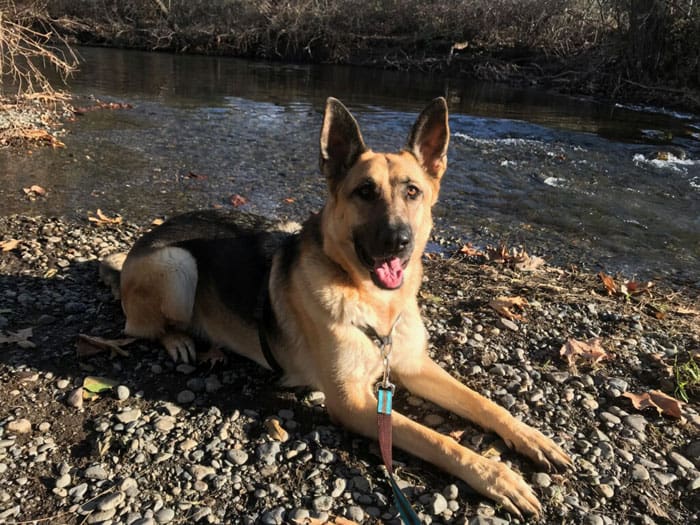
But adding to the unattractiveness of her total “package,” she had chronic, explosive diarrhea. She seemed to have no impulse to keep her kennel free of urine, either; she peed frequently in her kennel, no matter how many times and for how long she was walked outside. In fact, she seemed to prefer to “go” in her kennel; she would come in from a 45-minute walk during which she did not pee or poop, and immediately “go.” Also, she was highly reactive to any activity in the kennel. When you opened the door to the room where her kennel was, she would start spinning – liberally spraying her latest diarrhea and urine all over her kennel walls and herself.
Lovely.
I was not a fan of Annie. When Sarah asked me what I thought about her, I grimaced. “She’s a mess, physically and behaviorally. Who would or could ever adopt her?”
“Have you walked her yet?” Sarah asked me. “She’s actually really nice on a walk. And she loves people. She is happy to meet any human she sees. She just lights up! And she doesn’t pull!”
I rolled my eyes. Sarah can find something to like in any dog.
During the evacuation, the veterinary staff from the shelter made the rounds, visiting all of the evacuated animals. When the staff came to The Canine Connection, it was quickly determined that Annie needed medication for a urinary tract infection and for a giardia infection. The care she received didn’t mean she was off the euthanasia list, though. Nobody at the shelter saw anything to like about Annie, either.
In fact, I think Sarah may be the only one who looked at this giant young German Shepherd Dog and saw anything to like at all. When the shelter reopened and the few dogs that Sarah had not been able to find homes for went back to the shelter, Sarah asked if she could continue to foster Annie. The shelter manager, grateful to Sarah for her help, couldn’t say no, even though she had very little faith that Sarah could turn things around for Annie. But she agreed to let Annie stay with Sarah indefinitely. So Sarah took Annie home from The Canine Connection – to Sarah’s own home. And she started managing the dog’s life in an entirely new manner, trying to find the keys to making the dog adoptable.
Fixing the Whole Dog: Lots of Progress, Lots of Work
That was almost two years ago. Annie is still living in Sarah’s home. And Annie is an entirely different dog.
It has taken an enormous amount of work. I can’t think of anyone else I know who would have been so committed to turning this dog around – Sarah can be stubborn that way. Once she believes in a dog’s potential to live safely and happily in someone’s home, she won’t quit trying to make that happen.
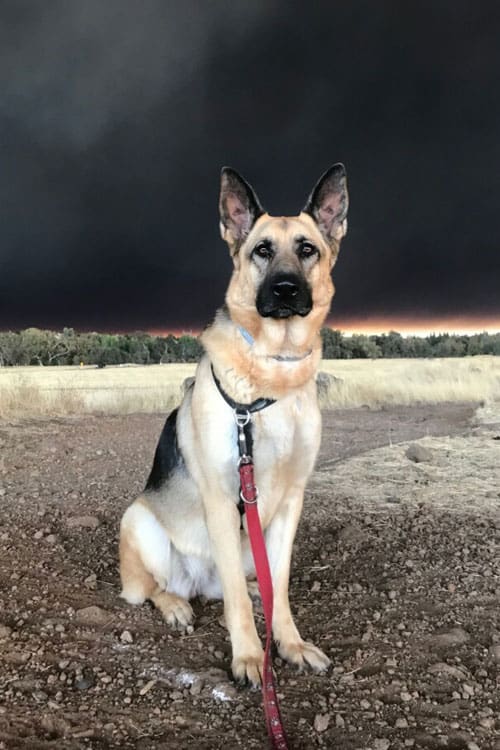
From the very first days, Sarah was heartened by Annie’s happiness at meeting people, and how good she was on walks. Annie loves getting outside and exploring the world. She’s interested and curious about everything; she will often stop and just observe something – not balking or spooked, just interested. And she’s not particularly reactive to passing dogs when out on walks! If the passing dog is calm, so is she; if the other dog barks or lunges, she will strike a similar posture, but, with a savvy handler, she can be redirected and calm again in a minute. So Sarah dug in and started a total dog-life makeover for Annie.
It took Sarah months to get Annie’s diarrhea stopped. A combination of prescription medications, a ridiculous amount of cleaning and sanitizing, probiotics, digestive enzymes and time eventually got it under control. Part of the problem was giardia, but even after the giardia was for sure cleared up, any sort of stressful event could bring the diarrhea back.
Sarah kept Annie separated from her other dogs at home while she tried to get to the bottom of Annie’s unpredictable dog-aggression. Annie seemed very curious about other dogs, and her body language and behavior consistently indicated that she was interested in playing.
Sarah used her own very dog-friendly, dog-savvy dogs to act as “neutral dogs,” and used leashes and long lines and wide-open spaces to see if Annie could learn to be comfortable around other dogs. But it seemed like Annie just didn’t “speak dog,” and could misinterpret any random signal from other dogs as an attack. She would freeze for a moment, and then dramatically launch an offensive; if not for alert handling and the long line, she could definitely hurt another dog.
To meet Annie’s exercise needs, to both burn off some of her excess mental and physical energy, Sarah hired a dog walker to take Annie for an hour-long walk every day. The more she exercised, the better her gaits and posture got. Sarah would occasionally send me photos or video of Annie playing fetch or walking, with notes that said, “She’s so much better! Look how tall she is now!” The wobbly gaits and plantigrade stance completely disappeared as the dog gained fitness.
Curious about the dog’s past, Sarah asked the shelter if they would pass along her contact information to the people who had surrendered Annie. The couple contacted Sarah, overjoyed to hear that the dog had ended up in the hands of a professional dog trainer. At Sarah’s request, they met to discuss Annie’s life to date and the people’s reason for surrendering the dog at 11 months of age.
The couple had bought Annie as a puppy to be a companion for their elderly Basset hound. Unfortunately, the Basset never liked Annie, and was quite aggressive toward her – until Annie grew to several times the Basset’s size, and had enough maturity to realize that she didn’t have to take the Basset’s abuse anymore. The dogs started fighting regularly, and Annie ended up in a crate most of the time – and when she was let out of the crate, she was a maniac. The people finally gave up and brought her to the shelter.
The back story certainly explained why Annie was so unpredictable and stressed about dogs, and why she had so little competence at relating to dogs. Her only experience with another dog was traumatic. The story also explained why she was so crippled and weak-looking when we first met her; she had probably been spending 23 hours a day in a crate.
Sarah used every tool in her dog-trainer’s toolbox to try to determine what amount, if any, of dog companionship Annie might be able to handle. She introduced Annie to lots of different dogs through fences, for safety. Annie wanted to play; she would run up and down the fence playfully, inviting chase games. Sarah found that Annie got along better with female dogs than males, and that she would tense up and be prone to making an attacking sort of lunge if introduced while on-leash, but rarely would do this if off-leash (or on a loose long line). If another dog showed aggression toward her, however, it was on. Like the former abuse victim she was, she seemed to say, “I’m never going down again without a fight.”
Sarah said it was the saddest thing ever the first time Annie saw a Basset Hound in her care. The dog, an amiable old soul, belongs to one of Sarah’s employees. Annie was at The Canine Connection that day for daycare (exercise in a private play yard). When she saw the Basset in an adjacent play yard, she ran in a blind terror, and hid, trembling.
At one of Annie’s veterinary visits, Sarah asked her vet about some sort of anxiety-reducing medication for the big German Shepherd, and the veterinarian agreed to a trial of fluoxetine (Prozac). Sarah said the drug made an almost immediate improvement in the dog’s anxiety level. She seemed more relaxed and playful, less guarded.
Annie Still Needs A Home
As the trainer worked with Annie, she would occasionally publish a social media post asking for help in trying to find a home for Annie.
Whenever someone who fosters a dog tells the dog’s story, someone will always make the observation, “She’s so happy with you!” followed immediately by the question, “Why don’t you just keep her??”
Sarah has been asked this question countless times. The simple answer is, because she owns three other dogs – and is always going to own more than one dog – and because she feels that Annie would be most successful and comfortable in a home where she was the only dog. (And no cats. Sarah has a cat, who does not approve of Annie one bit. Annie does not like cats.)
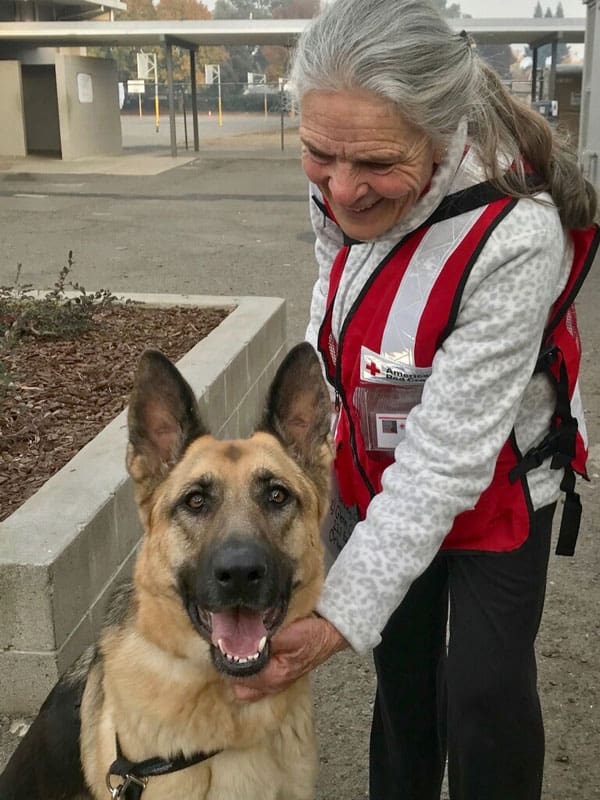
After many experiments in socializing the dog with other dogs, Sarah has learned that Annie is capable of making a dog friend and playing happily with that friend. But given her size (a very fit 95 pounds) and the speed and ferocity with which she is capable of taking offense by another dog’s actions, in Sarah’s professional opinion, it would be best if Annie were an only dog in someone’s home. Also, says Sarah, “Annie deserves to live with someone who really loves and needs a big friendly dog. She thrives on human attention and affection. She loves everyone she meets, from old people to youngsters – although, given her size, I think she would be best suited to a home with adults who were not frail, or has little kids.”
I admire Sarah’s commitment to this dog. I know for a fact that Annie would have been euthanized by my local shelter, had the dam disaster and evacuation not happened. And had Annie been adopted into a home with another dog, at some point, Annie would have been triggered and someone would have gotten grievously injured and Annie may well have found herself back on a shelter’s euthanasia list. Sarah saved this dog, and found all the good things about her: the dog’s intelligence and ability to learn, sensitivity to and curiosity about humans, her enjoyment of walking outdoors with her person, her sense of fun and playfulness.
But there is a real shortage of homes with no other dogs and no cats – only humans who are physically capable of living with a large, exuberant dog, and with people who will be committed and able to walk this large dog every day (she’s great on leash!). Many people have expressed interest in Annie over the past two years, but literally not one person has stepped forward who meets all the criteria Sarah knows Annie is going to need to be successful.
As I write this, Sarah is about to start construction on a huge expansion/remodeling project on her training center. The plans include a suite for Annie – a large private area with attached outdoor run, where Annie can have tons of room to live and play, without the stress of seeing or dealing with other dogs. The suite will allow her 24-hour access to the facility’s boarding and daycare staff (who all really love Annie, too), and is adjacent to Sarah’s office, so she will be near people at all times.
When the construction is complete, Sarah plans to move Annie to her new suite, so that her own dogs can finally have the run of her entire home, not just half of it, and she won’t have to go through multiple dog gates to travel from one end of her house to the other.
Having the dog reside at her business isn’t ideal, but on the other hand, Sarah has spent the past two years learning all about what works and what doesn’t work to keep Annie happy, healthy, and behaviorally consistent, and she knows she can continue to do the same. Sarah says she will keep the big dog for the rest of Annie’s days if she’s not able to find the right home. “I absolutely love Annie,” Sarah says. “She is happy right now, but she would be even happier if she was an only dog. I really want that for her – but I won’t let her go any place where she is doomed to fail. Humans failed her utterly in her first year, and she very nearly didn’t survive that.”
This isn’t necessarily the best time to try to find Annie a new home; there are hundreds of animals who have been displaced by the more recent disaster in this county (the Camp Fire), and dozens of people looking to rehome their pets due to their own dislocation.
In addition to the heroics she performed for the animals from the Northwest SPCA when the dam disaster happened, Sarah stepped up to put a program in place to help connect fire victims and people who are willing to foster displaced pets until their owners can find housing where they can have their pets. She’s been so crazily busy with that program and preparing for this massive construction project at her boarding/training facility, I know her own dogs are getting the short end of the stick – a common hazard for dogs who belong to overworked dog trainers!
The time I spent with Sarah volunteering to help the animals who were staying in the emergency evacuation shelter (from the Camp Fire) convinced me that Sarah could use a break, and some extra help in putting the word out about Annie’s need for a very special home.
If you know someone who needs Annie – and has what Annie needs – would you ask if they would contact Sarah Richardson via email? Reach her at Sarah@thecanineconnection.com.


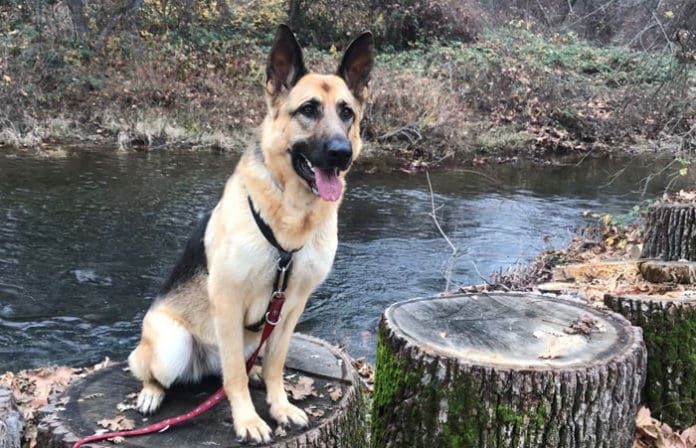
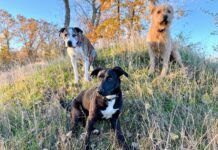
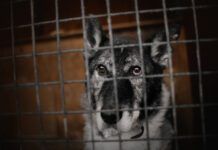
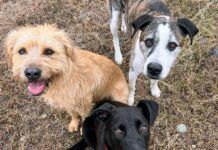
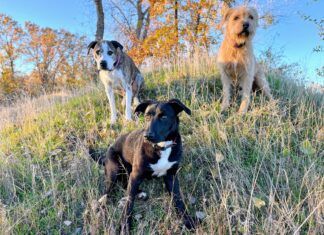
I have a rescue GSD who was almost as bad as Annie-almost gave up after he bit me! he completely changed his mind after abt. 8mos. of hell(I was actually afraid in my own house) & has become the most affectionate GSD (5 prior) I have had & the smartest which is saying a lot. He would have been great in so many areas IF whoever screwed him up had not! I tried several training experts & long-line & finally gave up – exercise is now several ball runs daily in lg. open area behind my house – he was in bad shape when I got him – back legs were atrophied & I orig. thought hip displ. etc. ’til a groomer said he had no muscle in back legs – he was found on st. w/o any id, 10lbs. underwt. loaded w/ fleas & bites & fractured front teeth!!!! after great medical care, food, exercise & living conditions & time – he is fab . but trainng is problem * all my past GSD had obedience training & walked & went to class & they were good w/ other dogs – he also has strong prey drive. Just wanted to let you know there are other GSD’s that thrive w/ care – thankyou for what you do & did.
We got our lovely girl from a high-kill shelter at 10 months old. She was found, was wild, and we wondered if we could keep her. We eventually sent her to ‘boot camp” with a trainer who trained dogs for the local police. After two weeks, he and his staff decided she was “un-trainable”, stubborn, had a mind of her own. We persisted. Long story short, she was the most loving, gentle, intelligent, beautiful dog ever, and we’ve always had shepherds. Yes, she had issues as she aged – two knee surgeries, laser treatments and acupuncture, a ton of vet bills. Despite all that, she was the best companion ever – traveled with us everywhere, felt safe driving cross-country with her. She unfortunately and suddenly passed away, after seventeen years with us, four months ago. She was a wise being, love her so much.
I hope Annie finds a wonderful home. I am planning on getting a cat have had them both all my life. I may know a friend that may b interested and will give them your info!
The unsung hero’s of many disasters, search and rescue dogs and their handlers search for the victims be they be lost, injured or deceased. We all are familiar with the pictures of SAR (search and rescue) dogs working the sight of a collapsed building or heading out into the wilderness to do the job only they can do. We as humans find it hard to fathom the dog’s ability to sense the tiny molecules that make up smells. It is estimated that some dog’s sense of smell is many thousands of times better than any human being. What is even more amazing is that the dog can discriminate between the molecules in the environment to the degree they can tell the direction to the victim or route they have traveled. Well trained search and rescue dogs do all this and more.